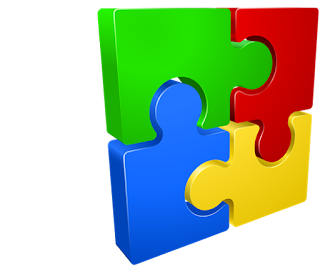Spatial ability is the comprehension
and recall of the spatial relations between objects. Spatial skills and math skills are related to
each other (see previous blog entry below).
When you improve your child’s spatial skills, you generally improve
their math skills as well. You don’t
have to use high tech or expensive methods to help your kids’ spatial
skills. Here are some easy ways to give
your kids an edge:
Board Games
Board Games give children a great
visual in the form of the board itself, and there are many that exercise
spatial skills. In clinical research, a
game similar to Chutes & Ladders with consecutively numbered, linearly
arranged, equal-size squares was shown to improve kids’ understanding of the
number line. Skippity is an easy visual
strategy game that anyone who knows how to “jump” in checkers can learn within
1 minute, and requires kids to visualize each move they are contemplating
before acting. Robot Turtles helps kids
understand the basics of programming displayed visually on a board. Escape Medusa's Rage allows kids to visualize and
understand the number line – including negative numbers – in a large, colorful
graphic.
Jigsaw Puzzles
Children who play with puzzles
develop better spatial skills. A recent study
by the University of Chicago found puzzle play to be an important predictor of
spatial skills even after controlling for differences in the parents’ education,
and household income. When doing a jigsaw
puzzle, children visualize where and how a particular piece will fit before
they try it. The trial and error aspect
reinforces their correct guesses and helps teach them why some of their guesses
are wrong. Children are stimulated to learn
by self-correction, and learn that persistence pays off. Some puzzles even combine logical thinking
with art appreciation, for example, puzzles of famous paintings such as Luncheon of the Boating Party by Renoir.
Building Blocks & Construction
Toys
Essential skills and ideas are
practiced and built up through block play, including measurement, estimation, comparison,
balance, and symmetry. Blocks and construction
toys come in such a wide variety of types – from traditional wood square cubes
to plastic bendable toys like Reptangles, Squigz Benders or Joinks to variety boxes
like Craft - Struction. Many Lego sets
come with plans that are given in pictures, not words, so that children can
create regardless of their reading or language skills. Kids sharpen their spatial skills by
comparing what they’ve built with the diagram and correcting any
inconsistencies.
Innovative STEM Toys
More complex than building blocks are
new toys that are designed to address the growing interest in STEM (Science,
Technology, Engineering, & Math). Kids
can learn by doing in the physical world, offline. Thames and Kosmos
Kids First Aircraft Engineer gives
kids the kit and instructions to build 10 simple airplane models including a
helicopter. Snap Circuits allows kids to create their own electronic games and gadgets. Goldiblox sets seek to inspire girls in
particular with toys like their create your own Zipline Action Figure (including
a doll that rides on the zipline).
Mazes
Mazes are purely visual and teach
kids to look before they leap. They can
choose from strategies like starting at both ends and meeting in the
middle. Printable mazes and toys that allow kids to create their own mazes are great ways for kids to practice spatial skills while having fun.
Coloring
Geometric pattern coloring books help kids create their own patterns
using color and careful attention to detail.
Patterns of the Universe demonstrates 17 mathematical themes such
as - Prime Numbers, Venn Diagrams, and Fractals.
Like this article? See more at: Amazing Wiz Kids






Don't forget chess - it combines visualization, visual memory, working memory, and logical thinking
ReplyDeletePlaying sports also helps these skills